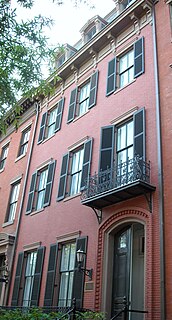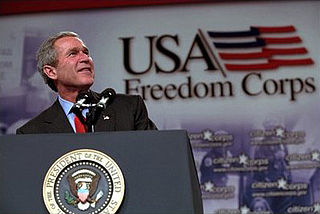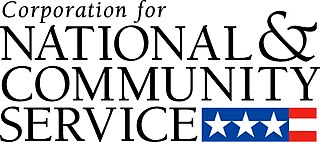
The National Park Service (NPS) is an agency of the United States federal government that manages all national parks, many national monuments, and other conservation and historical properties with various title designations. It was created on August 25, 1916, by Congress through the National Park Service Organic Act and is an agency of the United States Department of the Interior. The NPS is charged with a dual role of preserving the ecological and historical integrity of the places entrusted to its management while also making them available and accessible for public use and enjoyment.

The director of national intelligence (DNI) is the United States Government Cabinet-level official required by the Intelligence Reform and Terrorism Prevention Act of 2004 to:
The National Endowment for the Humanities (NEH) is an independent federal agency of the U.S. government, established by the National Foundation on the Arts and the Humanities Act of 1965, dedicated to supporting research, education, preservation, and public programs in the humanities. The NEH is housed at 400 7th St SW, Washington, D.C. From 1979 to 2014, NEH was at 1100 Pennsylvania Avenue, N.W., Washington, D.C. in the Nancy Hanks Center at the Old Post Office.

The White House Office of Faith-Based and Neighborhood Partnerships, formerly the White House Office of Faith-Based and Community Initiatives (OFBCI) is an office within the White House Office that is part of the Executive Office of the President of the United States.

A National Heritage Area is a site designated by United States and intended to encourage historic preservation of the area and an appreciation of the history and heritage of the site. There are currently 55 National Heritage Areas, some of which use variations of the title, such as National Heritage Corridor.

The National Historic Preservation Act is legislation intended to preserve historic and archaeological sites in the United States of America. The act created the National Register of Historic Places, the list of National Historic Landmarks, and the State Historic Preservation Offices.

USA Freedom Corps was a White House office and fifth policy council within the Executive Office of the President of the United States under George W. Bush, who as President served as its chair. Bush announced its creation during his 2002 State of the Union Address, and the Corps was officially established the next day, describing itself as a "Coordinating Council... working to strengthen our culture of service and help find opportunities for every American to start volunteering."

The Advisory Council on Historic Preservation (ACHP), an independent federal agency, is charged with the mission to promote the preservation of the nation's diverse historic resources. The ACHP advises the President and Congress on national historic preservation policy and also provides a public forum for stakeholders and the public to influence federal agency decisions regarding federal projects and programs that affect historic properties. The ACHP promotes the importance of historic preservation to foster an understanding of the nation's heritage and the contribution that historic preservation can make to contemporary communities, along with their economic and social well-being.
The President's Committee on the Arts and the Humanities (PCAH) was an advisory committee to the White House on cultural issues. It worked directly with the Administration and the three primary cultural agencies: the National Endowment for the Arts, National Endowment for the Humanities, and the Institute of Museum and Library Services, as well as other federal partners and the private sector, to address policy questions in the arts and humanities, to initiate and support public/private partnerships in those disciplines, and to recognize excellence in the field. Its core areas of focus were arts and humanities education, cultural exchange, and the creative economy.
The State Historic Preservation Office (SHPO) is a state governmental function created by the United States federal government in 1966 under Section 101 of the National Historic Preservation Act (NHPA). The purposes of a SHPO include surveying and recognizing historic properties, reviewing nominations for properties to be included in the National Register of Historic Places, reviewing undertakings for the impact on the properties as well as supporting federal organizations, state and local governments, and private sector. States are responsible for setting up their own SHPO; therefore, each SHPO varies slightly on rules and regulations. To link these differences with the SHPOs, the National Conference of State Historic Preservation Officers (NCSHPO) was created as a “point of contact” according to the National Historic Preservation Act.

The Texas Historical Commission is an agency dedicated to historic preservation within the state of Texas. It administers the National Register of Historic Places for sites in Texas.

The Corporation for National and Community Service (CNCS) is a U.S. federal government agency that engages more than five million Americans in service through AmeriCorps, Learn and Serve America, Senior Corps, and other national service initiatives. The agency's mission is to "support the American culture of citizenship, service, and responsibility". While a government agency, CNCS acts much like a foundation and is the nation's largest annual grant maker supporting service and volunteering. CNCS, formerly known as the "Corporation for National Service" or "CNS," was created as an independent agency of the United States government by the National and Community Service Trust Act of 1993.
The National Historic Preservation Act of 1966 (NHPA) envisioned a funding source to provide states with matching funds to implement the Act. The Act was to be implemented through partnerships with states, Indian Tribes, Native Hawaiians, local governments, nonprofit organizations, and the private sector. It brought forth state programs to implement much of the Act; a National Register of Historic Places encompassing a wide range of sites and structures deemed historic; partnerships at all levels of government; incentives; assistance; and reviews. The NHPA endorsed the use of federal financial support for the national preservation program and called for two basic categories of assistance, both of which provide funding, rather than technical assistance, for historic preservation projects and to individuals for the preservation of properties listed in the National Register of Historic Places. Since enactment in 1966, repeated efforts to fund the HPF was realized after a 10-year campaign when consistent funding was authorized on September 28, 1976, through Public Law 94-422. The law amended the National Historic Preservation Act to establish a funding source known as the Historic Preservation Fund for a historic preservation grant program to provide assistance to non-federal entities.

Save America's Treasures is a United States federal government initiative to preserve and protect historic buildings, arts, and published works. It is a public–private partnership between the U.S. National Park Service and the National Trust for Historic Preservation. The National Endowment for the Arts, Heritage Preservation, and the National Park Foundation also are allied.

The Omnibus Public Land Management Act of 2009 is a land management law passed in the 111th United States Congress and signed into law by President Barack Obama on March 30, 2009. The bill designates millions of acres in the US as protected and establishes a National Landscape Conservation System. It includes funding for programs, studies and other activities by the Department of the Interior and the Department of Agriculture, and in some cases bars further geothermal leasing, oil and gas leasing, and new mining patents on certain stretches of protected land.
The Department of Archaeology and Historic Preservation (DAHP) is an independent government agency in Washington state which serves several functions, including regulatory functions. The agency inventories and regulates archaeological sites; houses Washington's State Historic Preservation Officer, State Archaeologist, State Architectural Historian and State Physical Anthropologist; maintains the Washington Heritage Register and Heritage Barn Register; provides expertise on environmental impacts to cultural resources; administers historic preservation grants for heritage barns and historic county courthouses; encourages historic preservation through local governments; provides technical assistance for historic rehabilitation and using historic preservation tax credits; and maintains extensive GIS databases to catalog the state's historic and prehistoric cultural resources.

The White House Initiative on Educational Excellence for Hispanics is a multi-agency working group within the Department of Education charged with strengthening the nation's capacity to provide high quality education while increasing opportunities for Hispanic American participation in federal education programs. In addition, the Initiative serves as a resource for information related to closing the educational achievement gap for Hispanic Americans. Finally, the Initiative provides staffing to support and coordinate the mission of a President's Advisory Commission on Educational Excellence for Hispanics.

Preservation Action is an American 501(c)4 non-profit historic preservation advocacy organization. Preservation Action was created in 1974 to serve as the national grassroots lobby for historic preservation. The organization seeks to make historic preservation a national priority by advocating to all branches of the federal government for sound preservation policy and programs through a grassroots constituency of hundreds of members from throughout the United States. Preservation Action provides information and training, and encourages direct contact with elected representatives, with National Historic Preservation Advocacy Week being the highlight of advocacy and outreach efforts each year.

The White House Initiative on Asian Americans and Pacific Islanders is a United States governmental office that works to empower Asian Americans and Pacific Islanders (AAPIs) to improve the quality of their lives, raise the standard of living of their families and communities, and more fully participate in our economy. The Initiative also works with the Native Hawaiian community. The Initiative collaborates with the White House Office of Public Liaison and designated federal departments and agencies to increase AAPI participation in programs in economic development, commerce, business, education, health and human services, housing, environment, arts, agriculture, labor and employment, transportation, justice, veterans affairs, and community development.

Blackstone River Valley National Historical Park is a National Park Service unit in the states of Rhode Island and Massachusetts. The park was created for the purpose of preserving, protecting, and interpreting the industrial heritage of the Blackstone River Valley and the urban, rural, and agricultural landscape of that region. The Blackstone River Valley was the site of some of the earliest successful textile mills in the United States, and these mills contributed significantly to the earliest American Industrial Revolution. The subsequent construction of the Blackstone Canal, a few years after the successful completion of the Erie Canal, helped to sustain the region's industrial strength.














